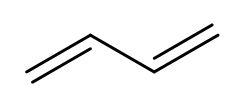
Answer
470.4k+ views
Hint: Polymerisation occurs through centres of radical formation. There are four radical centres in buta-1,3-diene as it has two double bonds present. The structure of buta-1,3-diene is

Just form the radicals and make the bonds between the radicals to produce three polymers of buta-1,3-diene.
Complete answer:
Free radical mechanism is a chain terminating type of polymerization. It occurs through formation of radicals at high temperature and pressure. Let us start forming the polymers.
The correct answer to this question is option ‘a’, ‘b’ and ‘c’.
Note: Do not form same type of polymers again and again by joining radicals formed at ${{\text{C}}_{1}}-{{\text{C}}_{2}}$ centre from the either side as the structure is symmetrical at ${{\text{C}}_{1}}-{{\text{C}}_{2}}$. So, be careful while forming polymers. The compounds formed will not be called as isomers as they are identical.

Just form the radicals and make the bonds between the radicals to produce three polymers of buta-1,3-diene.
Complete answer:
Free radical mechanism is a chain terminating type of polymerization. It occurs through formation of radicals at high temperature and pressure. Let us start forming the polymers.
| S. No. | Centres through which polymerization will take place | Mechanism of polymerization | Structures of polymers | Name of polymers |
| 1 | Carbon -1,2 or ${{\text{C}}_{1}}-{{\text{C}}_{2}}$ | In this, the double bond between ${{\text{C}}_{1}}-{{\text{C}}_{2}}$ will break into radicals and other molecules of buta-1,3-diene will also break from the same centre into radicals and then radicals of every other molecule will form single bond with each other and there is no breaking of another double bond. | 
| The name of the polymer is polyvinyl polythene. |
| 2 | Carbon -1,4 or ${{\text{C}}_{1}}-{{\text{C}}_{4}}$ | In this, all the double bonds breaks into radicals and radicals between ${{\text{C}}_{1}}-{{\text{C}}_{4}}$ will form single bond with other molecules of buta-1,3-diene will also break from the same centre into radicals. But here, the radicals at ${{\text{C}}_{2}}-{{\text{C}}_{3}}$ join together to form a bond and single bond was already present so, double bond is made. The hydrogen atoms are on the same side on the double bond, so ‘cis’ polymer is formed. | 
| The name of the polymer is cis-1,4-Polybutadiene. |
| 3 | Carbon -1,4 or ${{\text{C}}_{1}}-{{\text{C}}_{4}}$ | In this, all the double bonds breaks into radicals and radicals between ${{\text{C}}_{1}}-{{\text{C}}_{4}}$ will form single bond with other molecules of buta-1,3-diene will also break from the same centre into radicals. But here, the radicals at ${{\text{C}}_{2}}-{{\text{C}}_{3}}$ join together to form a bond and single bond was already present so, double bond is made. The hydrogen atoms are on the opposite side of the double bond, so a ‘trans’ polymer is formed. | 
| The name of the polymer is trans-1,4-Polybutadiene. |
The correct answer to this question is option ‘a’, ‘b’ and ‘c’.
Note: Do not form same type of polymers again and again by joining radicals formed at ${{\text{C}}_{1}}-{{\text{C}}_{2}}$ centre from the either side as the structure is symmetrical at ${{\text{C}}_{1}}-{{\text{C}}_{2}}$. So, be careful while forming polymers. The compounds formed will not be called as isomers as they are identical.
Recently Updated Pages
Fill in the blanks with suitable prepositions Break class 10 english CBSE

Fill in the blanks with suitable articles Tribune is class 10 english CBSE

Rearrange the following words and phrases to form a class 10 english CBSE

Select the opposite of the given word Permit aGive class 10 english CBSE

Fill in the blank with the most appropriate option class 10 english CBSE

Some places have oneline notices Which option is a class 10 english CBSE

Trending doubts
Fill the blanks with the suitable prepositions 1 The class 9 english CBSE

How do you graph the function fx 4x class 9 maths CBSE

Which are the Top 10 Largest Countries of the World?

What is the definite integral of zero a constant b class 12 maths CBSE

The Equation xxx + 2 is Satisfied when x is Equal to Class 10 Maths

Differentiate between homogeneous and heterogeneous class 12 chemistry CBSE

Define the term system surroundings open system closed class 11 chemistry CBSE

Full Form of IASDMIPSIFSIRSPOLICE class 7 social science CBSE

Change the following sentences into negative and interrogative class 10 english CBSE




